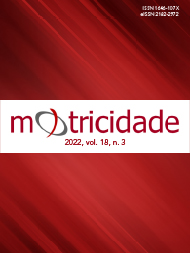Supine-to-stand task performance and anthropometric characteristics in children and adolescents
DOI:
https://doi.org/10.6063/motricidade.26680Keywords:
psychomotor performance, motor development, body mass index, childhood, adolescenceAbstract
The performance of getting up from the floor from a supine position (Supine-to-Stand task, STS) can be considered a milestone in motor development and a potential indicator of motor competence in global terms. However, the knowledge about the performance of STS task and anthropometric characteristics is limited. This study examined the relationship between STS task performance and anthropometry in youth and the differences between the sexes, range age and nationality. Participants (n= 397; 45% girls) from Spain and Brazil (M= 9.13 years; SD= 3.79) had the following variables measured: timed STS task, mass, height, chronological age, hip, and waist circumference; Body Mass Index (BMI), Waist/Hip Ratio (WHR), Waist/Height Ratio (WHtR) were calculated. The analysis included ANOVA, Pearson’s correlation test and Stepwise multiple regression analysis in four age groups. Age was the variable that obtained statistically significant associations with timed STS task in the youngest age group; the BMI in the children group corresponded to the second childhood phase, and the WHR and the WHtR in the oldest age group. The timed STS task decreased as age groups were increasingly older, confirming that timed STS is strongly associated with growth and maturation processes; there was no wide difference between sexes or nationalities.
Downloads
Published
Issue
Section
License
The authors of submitted manuscripts must transfer the full copyright to Journal Motricidade / Sílabas Didáticas Editions. Granting copyright permission allows the publication and dissemination of the article in printed or electronic formats, and copyrights start at the moment the manuscript is accepted for publication. It also allows Journal Motricidade to use and commercialise the article in terms of licensing, lending or selling its content to indexation/abstracts databases and other entities.
According to the terms of the Creative Commons licence, authors may reproduce a reasonable number of copies for personal or professional purposes, but without any economic gain. SHERPA/RoMEO allows authors to post a final digital copy (post-printing version) of the article on their websites or on their institutions' scientific repository.


